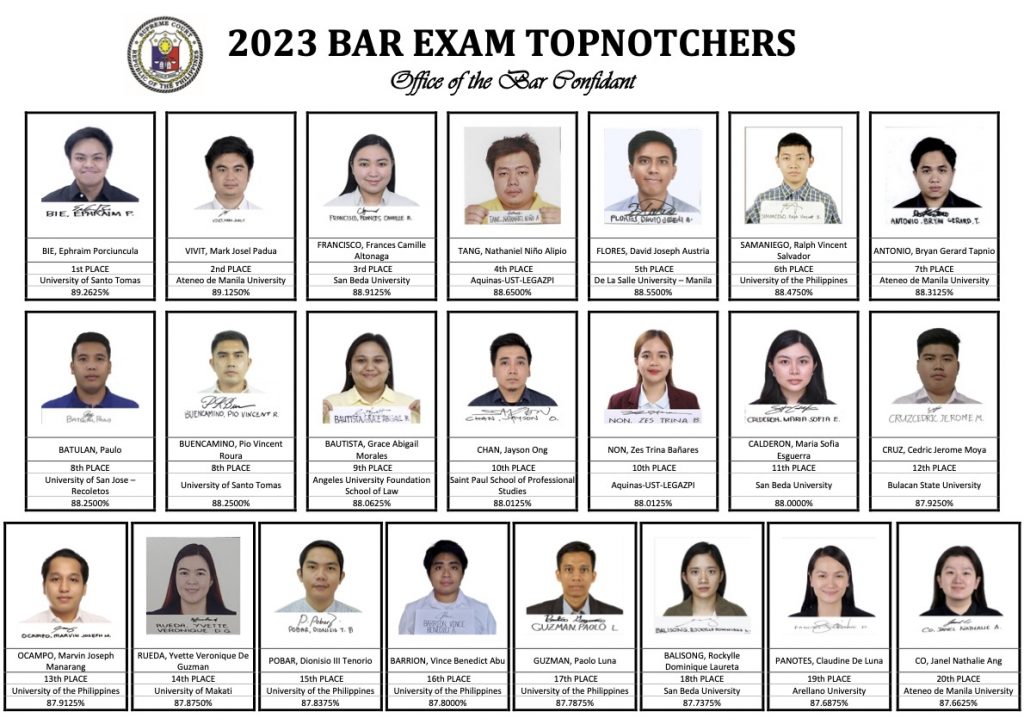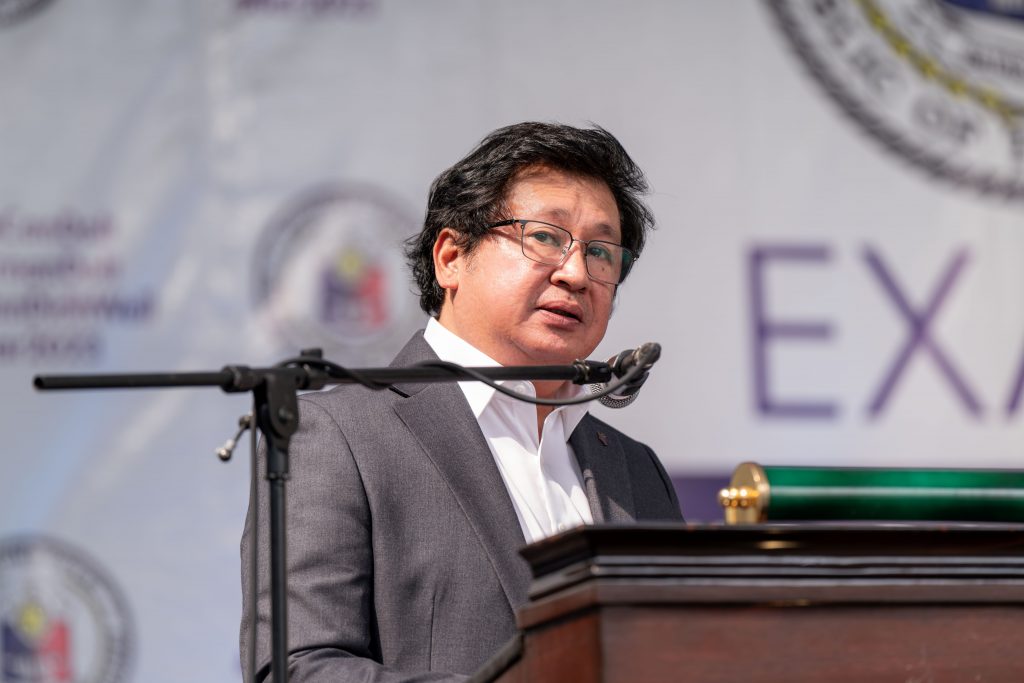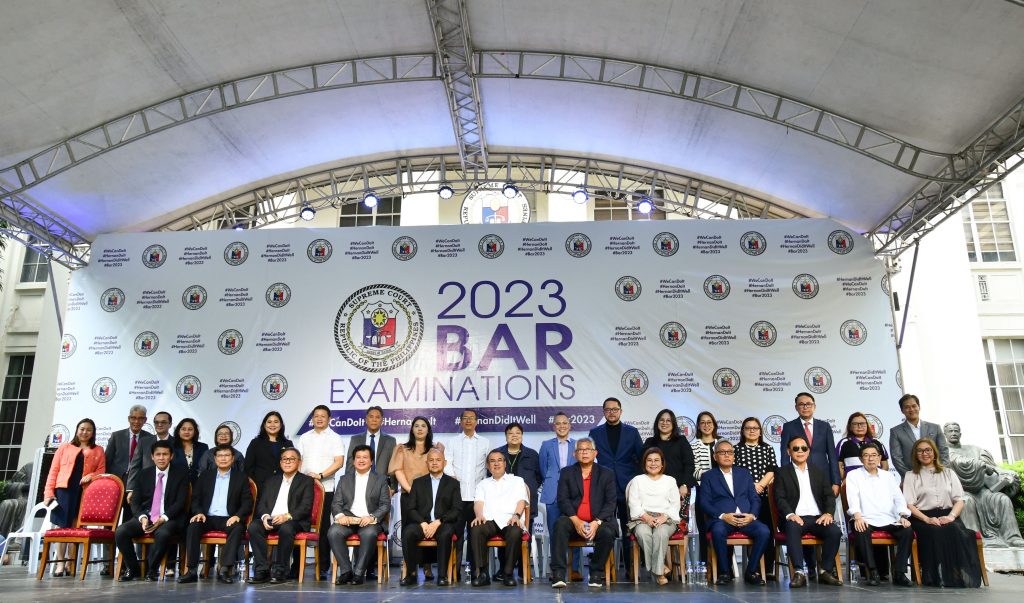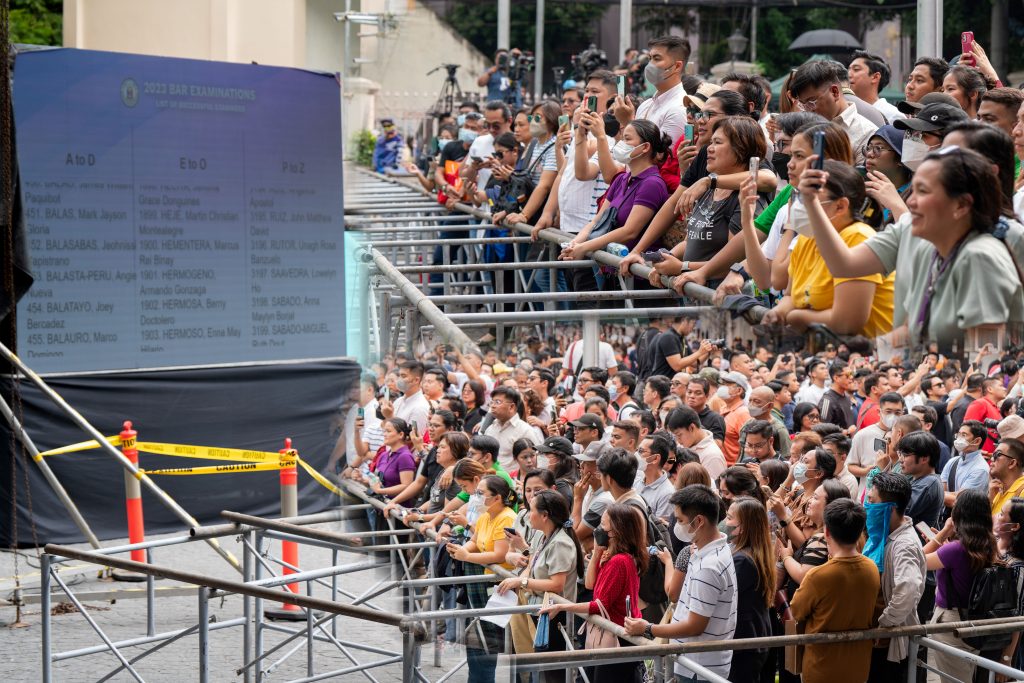3,812 NEW LAWYERS; THOMASIAN TOPS THE 2023 BAR EXAMS
December 5, 2023

Supreme Court Associate Justice Ramon Paul L. Hernando, Chairperson of the 2023 Supreme Court Committee on Bar Examinations, today announced that a total of 3,812 out of the 10,387 who completed all the tests during the three days of the exams passed the 2023 Bar Examinations.
This translates to a passing rate of 36.77%.
The Office of the 2023 Bar Chair had earlier announced that both the Oath Taking and the Roll Signing Ceremonies for the successful Bar examinees will take place on December 22, 2023 at the SMX Convention Center in Pasay City.
The 2023 Bar Examinations were held on September 17, 20, and 24, 2023 in 14 local testing centers spread out across the National Capital Region, Luzon, Visayas, and Mindanao. The said Examinations were the 121st professional licensure tests conducted for Philippine lawyers.
2023 Bar Topnotchers, Top Schools
Ephraim Porciuncula Bie, a graduate of University of Santo Tomas, topped this year’s Bar Examinations with the highest over-all rating of 89.2625%.
The Bar passers who obtained the 20 highest grades are as follows:
Rank | Name | School | Rating |
1 | BIE, Ephraim Porciuncula | University of Santo Tomas | 89.2625% |
2 | VIVIT, Mark Josel Padua | Ateneo de Manila University | 89.1250% |
3 | FRANCISCO, Frances Camille Altonage | San Beda University | 88.9125% |
4 | TANG, Nathaniel Niño Alipio | Aquinas-UST-LEGAZPI | 88.6500% |
5 | FLORES, David Joseph Austria | De La Salle University | 88.5500% |
6 | SAMANIEGO, Ralph Vincent Salvador | University of the Philippines | 88.4750% |
7 | ANTONIO, Bryan Gerard Tapnio | Ateneo de Manila University | 88.3125% |
8 | BATULAN, Paulo | University of San Jose – Recoletos | 88.2500% |
| BUENCAMINO, Pio Vincent Roura | University of Santo Tomas | 88.2500% |
9 | BAUTISTA, Grace Abigail Morales | Angeles University Foundation School of Law | 88.0625% |
10 | CHAN, Jayson Ong | Saint Paul School of Professional Studies | 88.0125% |
| NON, Zes Trina Bañares | Aquinas-UST-LEGAZPI | 88.0125% |
11 | CALDERON, Maria Sofia Esguerra | San Beda University | 88.0000% |
12 | CRUZ, Cedric Jerome Moya | Bulacan State University | 87.9250% |
13 | OCAMPO, Marvin Joseph Manarang | University of the Philippines | 87.9125% |
14 | RUEDA, Yvette Veronique De Guzman | University of Makati | 87.8750% |
15 | POBAR, Dionisio III Tenorio | University of the Philippines | 87.8375% |
16 | BARRION, Vince Benedict Abu | University of the Philippines | 87.8000% |
17 | GUZMAN, Paolo Luna | University of the Philippines | 87.7875% |
18 | BALISONG, Rockylle Dominique Laureta | San Beda University | 87.7375% |
19 | PANOTES, Claudine De Luna | Arellano University | 87.6875% |
20 | CO, Janel Nathalie Ang | Ateneo de Manila University | 87.6625% |
The ratings of the law schools were grouped per category (based on number of Bar candidates) and with a distinction of the ratings covering all Bar candidates and the ratings covering only first-takers.
The schools which obtained the five highest Bar passers’ percentages covering all Bar candidates in their respective categories are:
Law Schools with more than 100 candidates:
Rank | School | Percentage of Passers |
1 | Ateneo de Manila University | 93.18% |
2 | San Beda University | 90.07% |
3 | University of the Philippines | 88.35% |
4 | University of San Carlos | 83.89% |
5 | University of Santo Tomas | 72.39% |
Law Schools with 51 to 100 candidates:
Rank | School | Percentage of Passers |
1 | Polytechnic University of the Philippines | 75.86% |
2 | University of Cebu | 73.61% |
3 | Xavier University – Ateneo de Cagayan | 68.00% |
4 | Saint Louis University | 61.04% |
5 | University of Mindanao | 47.27% |
Law Schools with 11 to 50 candidates:
Rank | School | Percentage of Passers |
1 | University of Makati | 94.12% |
2 | Ateneo de Davao University | 87.76% |
3 | Angeles University Foundation School of Law | 82.61% |
4 | Notre Dame of Marbel University | 81.82% |
5 | University of Southeastern Philippines | 68.75% |
Law Schools with 10 or fewer candidates:
Rank | School | Percentage of Passers |
1 | Bicol University | 85.71% |
| St. Mary’s College of Tagum, Inc. | 85.71% |
2 | St. Thomas More School of Law and Business | 77.78% |
3 | Mariano Marcos State University | 71.43% |
4 | Manila Adventist College | 66.67% |
5 | Western Leyte College of Ormoc City, Inc. | 50.00% |
| St. Ferdinand College | 50.00% |
On the other hand, the schools which obtained the five highest Bar passers’ percentages for first-time candidates in their respective categories are:
Law Schools with more than 100 first-time candidates:
Rank | School | Percentage of Passers |
1 | Ateneo de Manila University | 94.08% |
2 | San Beda University | 92.20% |
3 | University of San Carlos | 90.91% |
4 | University of the Philippines | 89.45% |
5 | University of Santo Tomas | 85.25% |
Law Schools with 51 to 100 first-time candidates:
Rank | School | Percentage of Passers |
1 | University of Cebu | 76.67% |
2 | Xavier University – Ateneo de Cagayan | 71.79% |
3 | Far Eastern University | 58.90% |
4 | University of San Jose – Recoletos | 48.48% |
5 | Dr. V. Orestes Romualdez Educational Foundation | 45.24% |
Law Schools with 11 to 50 first-time candidates:
Rank | School | Percentage of Passers |
1 | University of Makati | 93.94% |
2 | Saint Louis University | 92.86% |
3 | Ateneo de Davao University | 90.70% |
4 | Bulacan State University | 89.47% |
| University of Mindanao | 89.47% |
5 | Polytechnic University of the Philippines | 86.67% |
Law Schools with 10 or fewer first-time candidates:
Rank | School | Percentage of Passers |
1 | St. Thomas More School of Law and Business | 100.00% |
| St. Mary’s College of Tagum, Inc. | 100.00% |
| Western Leyte College of Ormoc City, Inc. | 100.00% |
2 | Ateneo de Naga University | 88.89% |
3 | Bicol University | 85.71% |
4 | Saint Louis College | 80.00% |
5 | Father Saturnino Urios University | 77.78% |
The complete list of successful examinees may be viewed at https://sc.judiciary.gov.ph/, the official website of the Supreme Court of the Philippines, and its designated mirror sites.
2023 Bar Statistics, Four-Examiners Policy
A total of 10,387 completed all three days of this year’s Bar Examinations.
On the first day of the Examinations on September 17, 2023, 10,400 candidates completed the exams on Political Law and Public International Law (15%) and Commercial and Taxation Laws (20%). On the second day, September 20, 2023, 10,391 candidates completed the tests on Civil Law (20%) and Labor and Social Legislation (10%), while on the third day, September 24, 2023, 10,387 examinees finished the tests on Criminal Law (10%) and Remedial Law, Legal and Judicial Ethics with Practical Exercises (25%).
The 2023 Bar Examinations adopted a four-examiner policy.
The examiners are:
1. Prof. Juanito G. Arcilla 2. Dean Sedfrey M. Candelaria 3. Prof. Ranulfo G. Mendoza 4. Prof. Antonio Eduardo S. Nachura, Jr. | Political Law and Public International Law |
1. Prof. Timoteo B. Aquino 2. Prof. Ignatius Michael D. Ingles 3. Dean Cesar L. Villanueva 4. DOTr Undersecretary Reinier Paul R. Yebra | Commercial and Taxation Laws |
1. Associate Justice Selma Palacio Alaras 2. Prof. Edwin M. Carillo 3. Atty. Rodolfo Ma. A. Ponferrada 4. Judge Jocelyn Sundiang-Dilig | Criminal Law |
1. Dean Marianne Elizabeth P. Beltran-Angeles 2. Dean Ma. Ngina Teresa V. Chan-Gonzaga 3. Associate Solicitor General Marissa B. Dela Cruz-Galandines 4. Dean Joan S. Largo | Civil Law |
1. Prof. Blessilda B. Abad-Gamo 2. Prof. Imelda M. Abadilla-Brown 3. Prof. Erdelyne C. Go 4. Atty. Ma. Teresa Antonia F. Fabregas | Labor and Social Legislation |
1. Prof. Irene Mae B. Alcobilla 2. Associate Justice Eduardo B. Peralta, Jr. 3. Associate Justice Germano Francisco D. Legaspi 4. Prof. Tranquil Gervacio S. Salvador III | Remedial Law, Legal and Judicial Ethics with Practical Exercises |
Comparative Statistics on the Bar Exams Results
The OBC, which administers the annual Bar Examinations, is also the repository of the records and data on Bar admission. It provides these comparative statistics on Bar Examination results from the year 2000 to 2023:
Year | Passers/Total Examinees | Passing Percentage |
2000 | 979/4,698 | 20.48% |
2001 | 1,266/3,849 | 32.98% |
2002 | 917/4,659 | 19.68% |
2003 | 1,108/5,349 | 20.71% |
2004 | 1,659/5,249 | 31.61% |
2005 | 1,526/5,607 | 27.22% |
2006 | 1,893/6,187 | 30.60% |
2007 | 1,289/5,626 | 22.91% |
2008 | 1,310/6,364 | 20.58% |
2009 | 1,451/5,903 | 24.58% |
2010 | 982/4,847 | 20.26% |
2011 | 1,913/5,987 | 31.95% |
2012 | 949/5,343 | 17.76% |
2013 | 1,174/5,292 | 22.18% |
2014 | 1,126/5,984 | 18.82% |
2015 | 1,731/6,605 | 26.21% |
2016 | 3,747/6,344 | 59.06% |
2017 | 1,724/6,748 | 25.5% |
2018 | 1,800/8,158 | 22.07% |
2019 | 2,103/7,685 | 27.36% |
2020/21 | 8,241/11,402 | 72.28% |
2022 | 3,992/9,183 | 43.47% |
2023 | 3,812/10,387 | 36.77% |
All announcements regarding the 2023 Bar Examinations may be viewed at https://sc.judiciary.gov.ph/bar-2023/. (Courtesy of the Supreme Court Public Information Office)

Supreme Court Associate Justice Ramon Paul L. Hernando, 2023 Bar Examinations Chairperson, announces that a total of 3,812 out of the 10,387 who completed all the tests during the three days of the exams passed this year’s Bar Examinations, which translates to a passing rate of 36.77%. (Courtesy of the Supreme Court Public Information Office)

Chief Justice Alexander G. Gesmundo, Senior Associate Justice Marvic M. V. F. Leonen, and Associate Justice Ramon Paul L. Hernando, 2023 Bar Examinations Chairperson, pose for posterity with the other Members of the Supreme Court after the announcement of the top 20 passers and top schools. With them are (standing) the Examiners of the 2023 Bar Examinations. (Courtesy of the Supreme Court Public Information Office)

All eyes are glued either to their gadgets or on the LED wall at the Supreme Court courtyard as the names of the 2023 Bar Examinations passers are flashed on the screens. (Courtesy of the Supreme Court Public Information Office)












